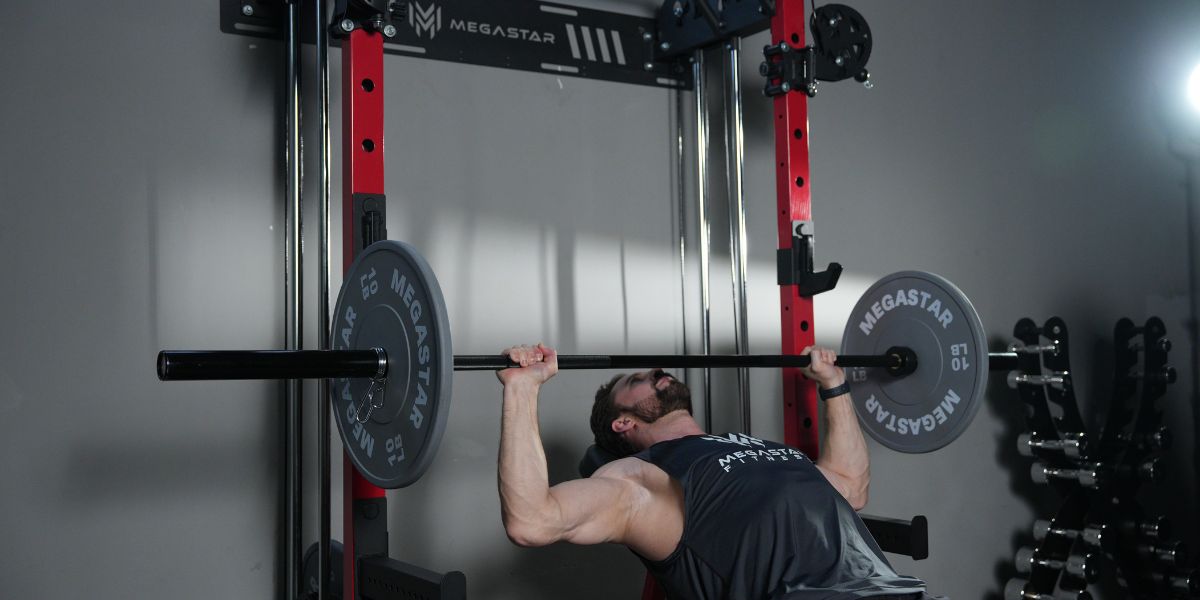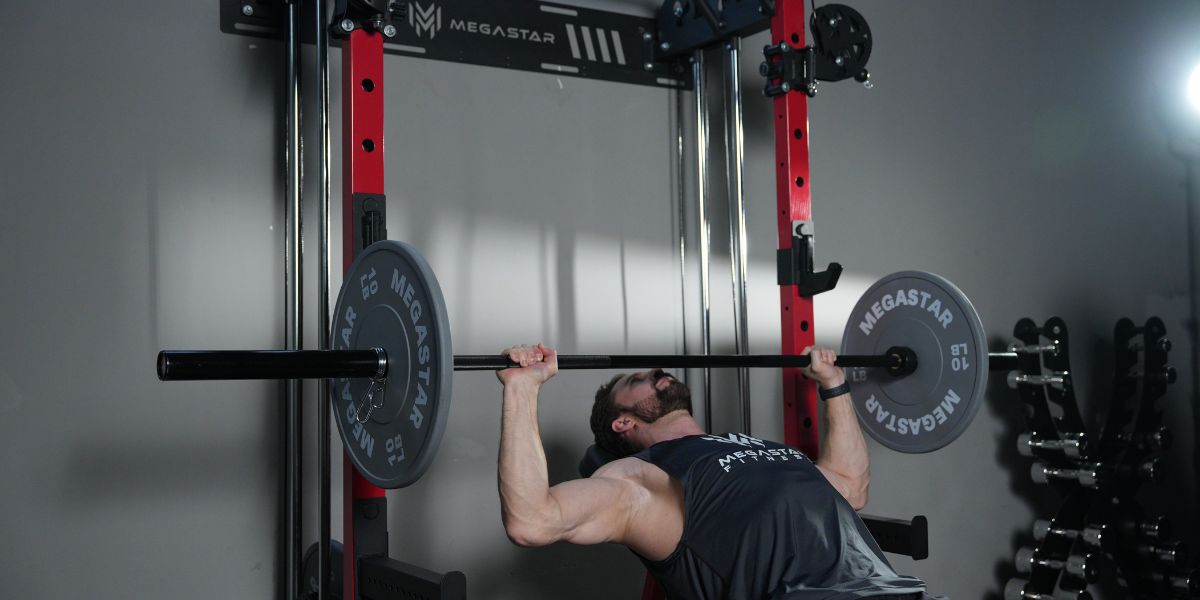Choosing the right barbell is one of the first and most critical decisions you'll make when building a home gym or upgrading your equipment. It's the centerpiece of your training, the tool you'll interact with on nearly every major lift. But with terms like "Olympic," "standard," "tensile strength," and "knurling" thrown around, it's easy to get overwhelmed.
This guide is for anyone trying to cut through the noise. Whether you're a complete beginner setting up your first garage gym or an intermediate lifter deciding if it's time to upgrade, we'll break down the differences between Olympic and standard barbells to help you invest wisely in your strength journey.
What Is An Olympic Barbell?
An Olympic barbell is the industry standard for serious strength training, found in commercial gyms, CrossFit boxes, and well-equipped home gyms worldwide. It's defined by its ~2-inch diameter rotating sleeves, which hold the weight plates. This feature allows the plates to spin independently of the bar, reducing torque on your wrists and elbows during dynamic movements like the clean and jerk.
Core Specs And Variations
- 2 in rotating sleeves on a 28–29 mm shaft; men’s bars are 20 kg/44 lb, women’s bars are 15 kg/33 lb at 25 mm shaft.
- Variants include multipurpose bars, dedicated power bars (stiffer, more aggressive knurl), and weightlifting bars (more whip and bearing spin).
When It Shines
- Works seamlessly with racks, bumper plates, and standard 2 in collars.
- Smooth sleeve rotation protects wrists and elbows on cleans, snatches, and presses.
- Higher load ratings support long-term strength progression.
What Is A Standard Barbell?
A "standard" barbell is primarily defined by its smaller, 1-inch diameter sleeves and shaft. These are the bars you typically find in all-in-one weight sets at big-box sporting goods stores. They are generally shorter, lighter, and much cheaper than their Olympic counterparts.
Core Specs And Common Use Cases
- 1 in non-rotating sleeves; often shorter and lighter.
- Common in older home sets or temporary setups for curls, light presses, or rehab.
Limitations To Know
- Lower load capacity and shorter sleeves limit plates you can load.
- Often too narrow between collars for modern squat racks and benches.
- 1 in plates and collars are not cross-compatible with 2 in Olympic systems without adapters.
Quick Answer And Comparison Table
For those in a hurry, here’s the bottom line: If you are serious about lifting weights for the long term, you should buy an Olympic barbell. Its versatility, higher weight capacity, compatibility with quality equipment, and superior performance make it the undisputed choice for compound exercises like squats, bench presses, and deadlifts. A standard barbell is only suitable for very light, accessory-style workouts or as a temporary, budget-conscious starting point.
Here’s a detailed look at how they stack up:
|
Feature |
Olympic Barbell |
Standard Barbell |
|
Sleeve Diameter |
2 inches (~50 mm) |
1 inch (~25.4 mm) |
|
Shaft Diameter |
~28−29 mm |
~25−28 mm (often 1 in) |
|
Typical Weight |
~45 lbs (20 kg) or 33 lbs (15 kg) |
Varies greatly, often 15−25 lbs |
|
Typical Length |
~7.2 ft (2.2 m) |
5−6 ft |
|
Sleeve Spin |
Bearings or Bushings |
None / Minimal (sleeves often fixed) |
|
Load Rating |
600 lbs to 1,500+ lbs |
100 lbs to 250 lbs |
|
Tensile Strength |
Typically 150,000 PSI+ |
Rarely specified, much lower |
|
Between Collars |
~51.5 inches (fits standard racks) |
Varies, often too short for racks |
|
Sleeve Length |
~16 inches |
~8−10 inches |
|
Finishes |
Hard Chrome, Stainless, Cerakote, etc. |
Often basic chrome or paint |
|
Price Range |
$150 - $1,000+ |
$30 - $100 |
|
Resale Value |
Good to Excellent |
Poor |
Olympic vs Standard Barbells: The Key Differences
Understanding the details is key to appreciating why the Olympic bar is the better long-term investment.
Weight, Length, And Between-Collars Fit
An Olympic bar's ~7.2-foot length isn't arbitrary. The shaft section between the collars is standardized to fit perfectly on squat racks, which have uprights spaced about 49 inches apart. Most standard bars are only 5 or 6 feet long, meaning the collars sit inside the rack's J-cups, making them unusable for squatting or benching.
Collar And Shaft Diameter
This is the most obvious difference. The Olympic bar’s 2-inch sleeves open up a massive world of high-quality plates, including rubber-coated, urethane, and bumper plates. Standard bars are restricted to 1-inch plates, which are almost exclusively basic cast iron. The shaft diameter of an Olympic bar (28−29 mm) is also optimized for grip strength during heavy pulls, while standard bar shafts are often a skinny 25 mm (1 in), which can feel less stable.
Sleeves And Spin
Olympic bar sleeves are designed to spin using either bushings (self-lubricating metal sleeves, durable and great for slower lifts) or bearings (caged needles or balls that provide a faster, smoother spin ideal for Olympic weightlifting). This spin is crucial for protecting your joints. Standard bars have fixed sleeves that don't rotate, meaning the entire weight's inertia twists against your wrists.
Whip, Stiffness, And Knurling
Power bars are stiff with aggressive knurl and often a center knurl for squats. Weightlifting bars have more whip for cleans and snatches. Standard bars vary widely and rarely advertise whip or knurl consistency.
Load Rating, Tensile Strength, And Safety
Good Olympic bars publish tensile strength (e.g., 190k–220k PSI) and yield ratings. Standard bars seldom do, reflecting lower and less predictable capacity.
Sleeve Length And Real Plate Capacity
Longer Olympic sleeves mean more room for plates, especially thick bumpers. Standard bars run out of space fast.
Finishes And Corrosion Resistance
Stainless and hard chrome resist rust best. Black oxide feels great but needs care. Budget chrome or paint on standard bars chips easily.

Why Choose Olympic Barbells?
You should invest in an Olympic barbell if you value:
- Safety: They are built to handle heavy loads without bending or breaking.
- Longevity: A good Olympic bar is a buy-it-for-life purchase.
- Performance: The spin, whip, and knurling are engineered to help you lift more effectively and safely.
- Compatibility: They work with the universal standard of racks, benches, and weight plates.
- Progress: This is the only tool that will grow with you from your first day of lifting to your strongest.
Why Choose Standard Barbells?
A standard barbell may be a reasonable choice only if:
- Budget is the absolute primary concern: They are significantly cheaper upfront.
- You only plan to lift very light weight: For curls or other accessory work where the load will remain under 100 lbs.
- Space is extremely limited: Their shorter length can be an advantage in tight quarters.
A Great Barbell to Start Your Journey
Making the decision to invest in an Olympic barbell is the first step. The next is finding one that offers the quality you need without breaking the bank, especially if you're building a home gym. For that, we recommend the MEGASTAR 7ft 20kg Olympic Barbell.
It hits all the essential specs we've discussed: it's a standard 20kg, 7-foot bar with rotating sleeves and secure grip knurling, ensuring it’s compatible with your rack and plates. With a robust 750lb capacity, it provides more than enough of a safety margin for the vast majority of lifters to progress for years. It’s an ideal, all-around choice that perfectly balances performance and value, making it a solid foundation for any serious home gym.
Conclusion
The choice between an Olympic and a standard barbell is a classic case of short-term savings versus long-term investment. While a standard bar's low price is tempting, its limitations in weight capacity, safety, and compatibility make it a dead-end street for anyone serious about getting stronger.
The Olympic barbell is the foundation of effective strength training. It's safer, more versatile, and will grow with you for decades. By investing in a quality Olympic bar and plates from the start, you are building a gym on a platform that has no ceiling. Assess your budget, consider your long-term goals, and choose the tool that will best serve you on your path to strength.
FAQs
Do I Need Bearings Or Are Bushings Enough?
Bushings are durable and smooth for powerlifting and general training. Bearings spin faster and are great for Olympic lifts and high-rep cycling, but they’re not mandatory for most home gyms.
Will An Olympic Bar Be Too Long For A Small Room?
A 7 ft bar fits most home setups if your rack is placed away from walls. Measure doorways, ceiling height, and your lifting lane before buying.
What’s A Reasonable Starter Budget?
Prioritize the bar, plates, and flooring. A solid entry-level Olympic bar, basic iron or bumper set, and good collars will carry you for years.
How Should I Store My Bar?
Vertical gun-racks or horizontal bar holders are best. Avoid leaning a loaded bar against a wall; long-term bending can occur.








